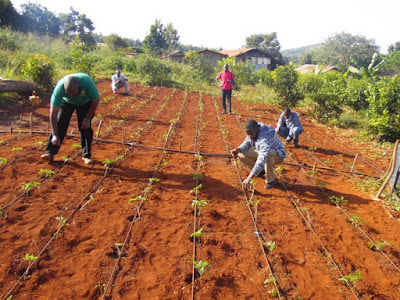By Caroline Wambui
KUNENE - Dressed in brown overalls, gumboots and a hat, John Njeru kneels and scoops up a handful of soil at his small farm in central Kenya, where he grows tomatoes, spinach and carrots.
"Not only has there not been enough rain in the past few months, it's also been unevenly distributed," he said, picking through the earth in his hand. "This destroys our crops."
Dealing with more unpredictable and irregular rainfall associated with climate change is a challenge for many farmers, and one made worse by water-wasting, inefficient irrigation systems, experts say.
But scientists from Kenya's Meru University of Science and Technology have come up with one way to deal with the problem: a mobile app that monitors the need for water in fields and controls irrigation equipment to deliver just what is needed.
"Farmers in the region traditionally water crops with cans or buckets", an inefficient way of getting water to plants, said Daniel Maitethia, an electronics lecturer at Meru University.
"The lack of measuring also means they water crops unevenly - so some may get too much water, and others not enough," he said.
 |
|
Daniel Maitethia (L) with students at Meru University’s farm,Kenya. TRF/Caroline Wambui
|
The "sensor-based automatic irrigation system" app, launched last year, uses sensors placed throughout a field to determine if soil is moist enough.
If it's too dry, a control unit uses solar panels to open the valve of a water tank, then close it again when the soil is damp enough.
Initially tested at the university's own farm, the irrigation system is now being rolled out to the public - including farmers like Njeru.
"We can't yet quantify how many farmers are using the app, but hope to expand it to thousands across Meru County - and potentially the rest of the country if the system proves successful," Maitethia said.
The combined app and irrigation system cost 50,000 Kenyan shillings ($480) per quarter of an acre, including solar panels and two drip irrigation lines. The system can be expanded to an additional quarter acre for 5,000 Kenyan shillings ($48).
COST AND BENEFITS
While Maitethia acknowledges the upfront cost of the system is high, he believes it will not only curb water waste but save labour costs as it does not require farmers to physically monitor it.
"If there is a glitch in the system, the farmer receives a text message notifying him of the problem," he explained. "A technician employed by the university will then help the farmer remotely with instructions, or physically come to the farm if needed."
Depending on the severity of the problem, a consultation with a technician can cost the farmer up to 500 Kenyan shillings (about $5).
Njeru, who paid 75,000 Kenyan shillings ($721) to install the app and irrigation system on his 1.5-acre farm, said that "although the app is expensive, it's a cost worth paying when I compare my current harvest to previous years."
"I used to lose up to 70 percent of my produce as a result of dry weather and inefficient irrigation, compared to only 10 percent now," he said.
Njeru used to occasionally hire other farmers to help water his farm on a day-to-day basis. Now he no longer needs to do so, he said.
"That saves me 20,000 Kenyan shillings ($192) per month," he said.
Maitethia thinks that as more people buy the app, its cost could reduce by more than half.
The project was awarded 1 million Kenyan shillings ($9,600) by the Water Services Trust Fund in November as the best innovation in water management, he said.
"This prize - and hopefully partnerships with other organisations - should make the technology available to small as well as large-scale farmers."
Article originally published at Building Resilience and Adaptation to Climate Extremes and Disasters (BRACED).





